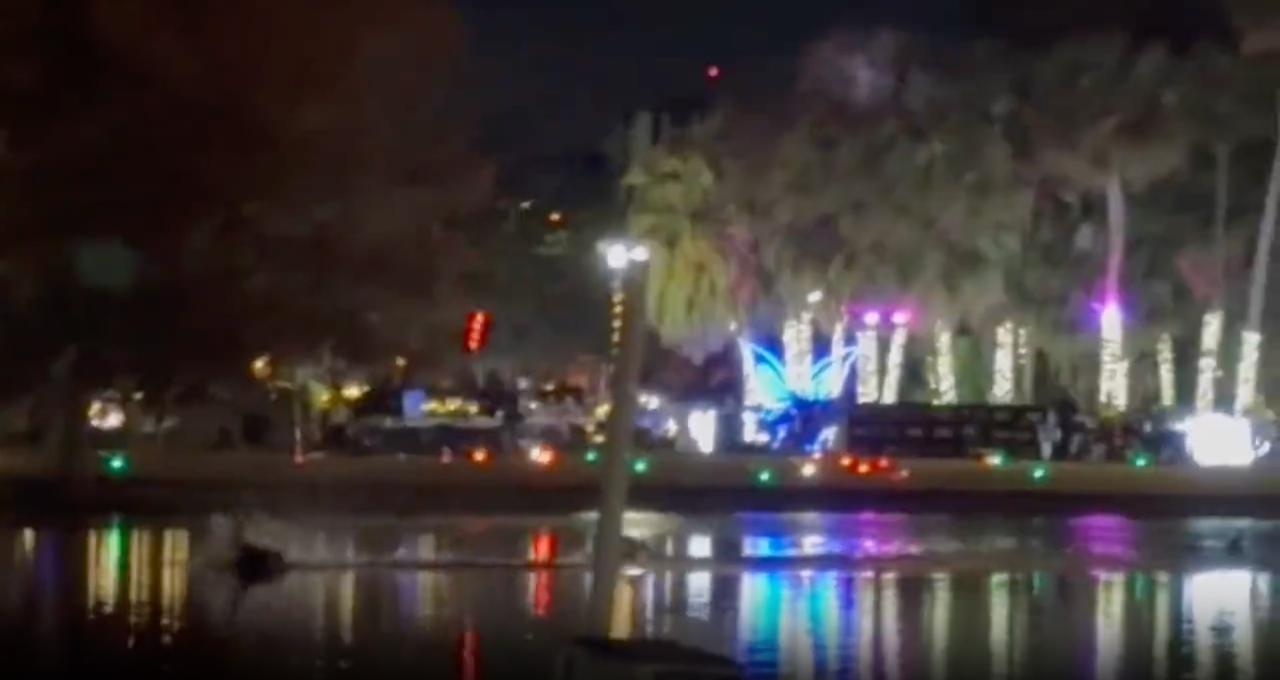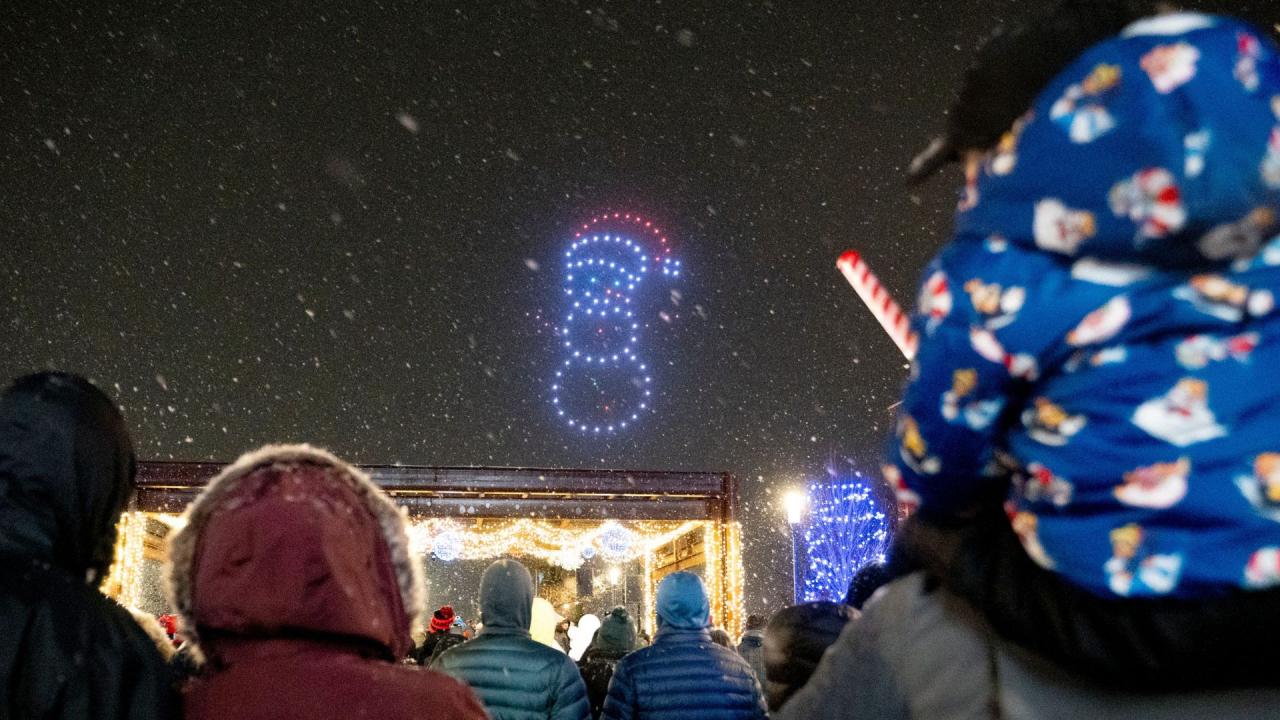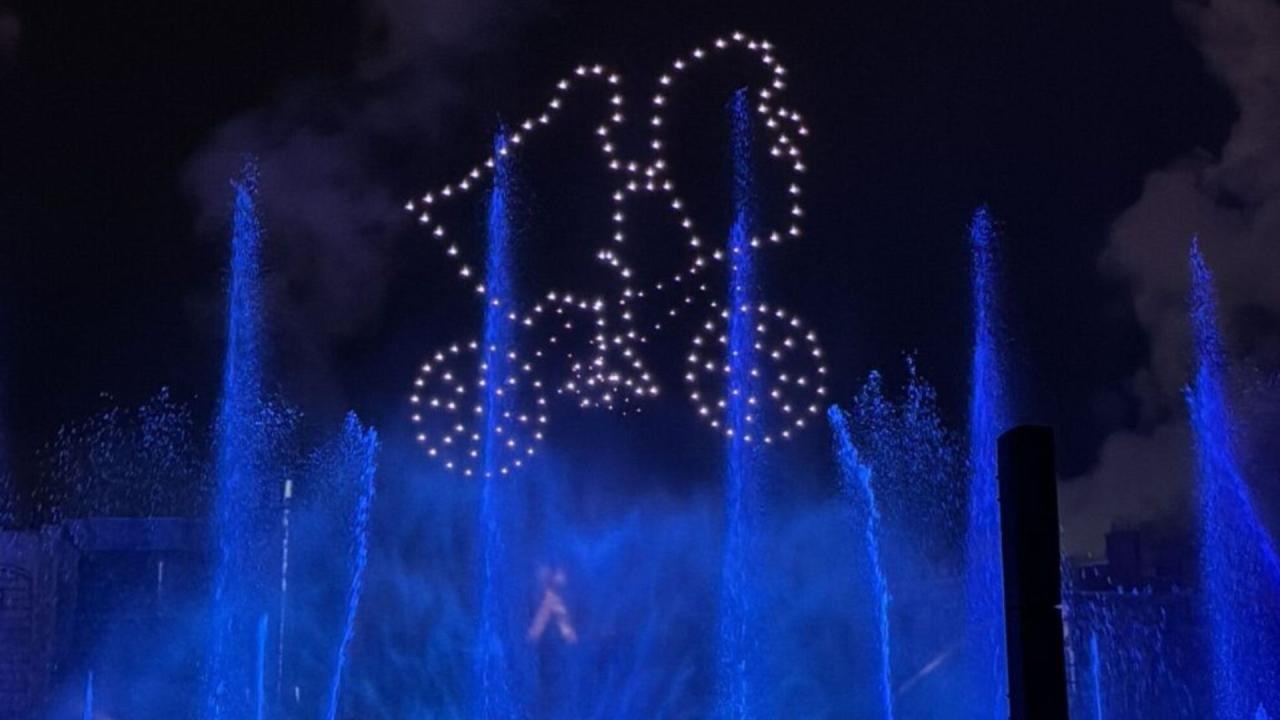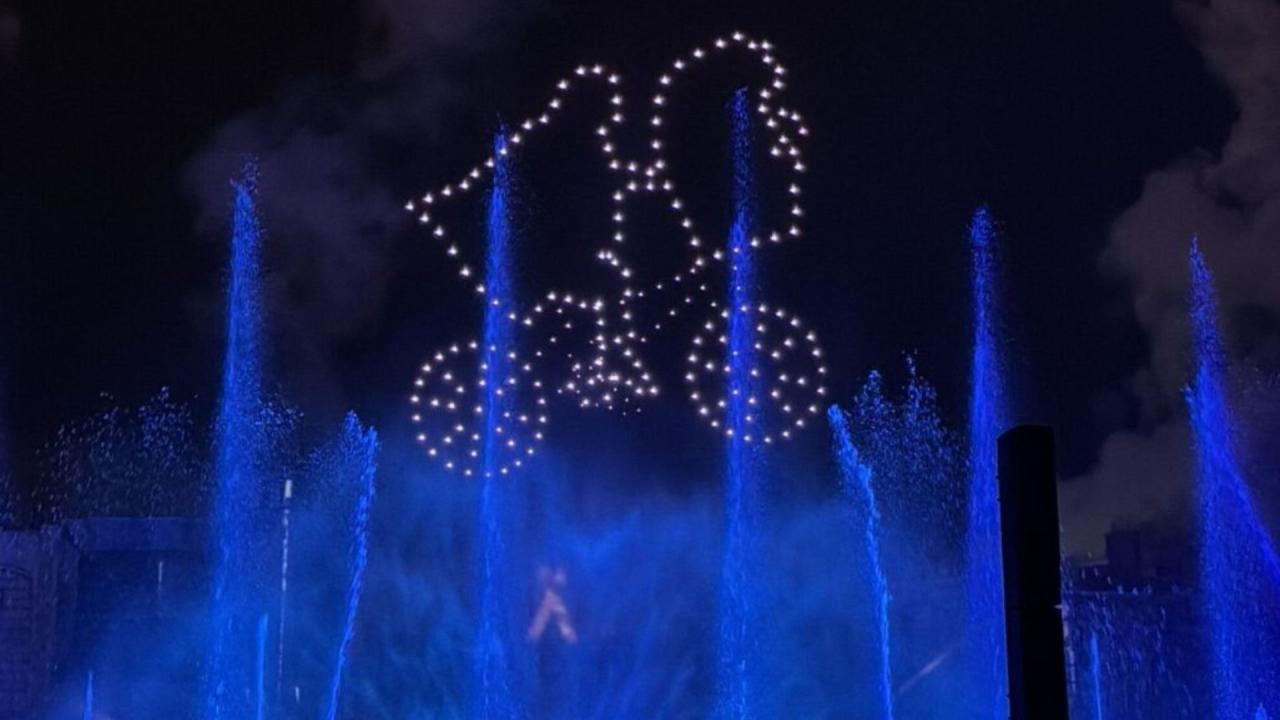Orlando drone show accident: A spectacular drone display turned unexpectedly dangerous, leaving many questioning safety protocols and the future of these increasingly popular events. This report delves into the details surrounding this incident, examining the circumstances, injuries, regulatory aspects, and the ongoing investigation. We’ll explore the technology involved, public reaction, and ultimately, what steps can be taken to prevent similar accidents.
We’ll cover everything from the initial malfunction and resulting chaos to the aftermath, including investigations, regulatory changes, and the long-term impact on the drone industry and public perception. Expect a factual account, complete with timelines, damage assessments, and expert insights.
Accident Details

The Orlando drone show accident, while not resulting in significant injuries or property damage beyond the drones themselves, serves as a valuable case study in the potential risks associated with large-scale drone operations. This incident highlights the importance of meticulous planning, robust safety protocols, and real-time monitoring capabilities in ensuring the safe and successful execution of such events.
Circumstances Surrounding the Accident
The accident involved a malfunction during a scheduled drone light show over a large public space in Orlando. Preliminary reports suggest a combination of factors may have contributed, including potential software glitches, unexpected wind gusts, or communication interference. A full investigation is underway to determine the precise cause. The show was organized by a reputable company with experience in large-scale drone displays, yet unforeseen circumstances led to the incident.
Drone Specifications and Types
The show utilized a fleet of approximately [Insert Number] commercially available drones, likely a model commonly employed for large-scale displays. These drones are typically equipped with high-intensity LED lights, GPS modules for precise positioning, and sophisticated flight control systems. Specific model numbers and detailed specifications are pending release from the investigating authorities, as well as the company that organized the show.
Timeline of Events
The drone show commenced at [Insert Time]. The display progressed smoothly for approximately [Insert Duration] before the incident occurred. At [Insert Time of Incident], several drones deviated from their programmed flight paths, resulting in collisions and subsequent crashes. Emergency protocols were immediately initiated, and the remaining drones were safely landed. Post-accident analysis of flight logs and drone data is crucial in understanding the sequence of events leading to the malfunction.
Weather Conditions
At the time of the incident, weather conditions in Orlando were reported as [Insert Weather Conditions, e.g., partly cloudy with light winds]. While initial reports suggest the weather was not severe, even mild wind gusts or unexpected changes in atmospheric pressure can affect the stability and performance of drones, especially during complex, coordinated maneuvers. The impact of weather conditions on the accident is a key area of investigation.
Key Facts Summary
| Time | Event | Location | Affected Parties |
|---|---|---|---|
| [Insert Time of Show Start] | Drone show commences | [Insert Location, e.g., Lake Eola Park] | Drone show organizers, audience |
| [Insert Time of Incident] | Multiple drones malfunction and crash | [Insert Specific Location of Crash, if known] | Drone show organizers |
| [Insert Time of Show End] | Show aborted; emergency protocols enacted | [Insert Location] | Drone show organizers, audience |
| [Insert Time] | Investigation initiated | [Insert Location] | Investigating authorities, drone show organizers |
Injuries and Damages
The Orlando drone show accident resulted in a range of injuries and damages, impacting individuals, property, and the environment. The severity of these impacts varied, highlighting the need for stringent safety protocols in drone operations, especially those involving large-scale public displays. The following details provide a clearer picture of the consequences.
The accident involved a malfunctioning drone that fell from a significant height. This resulted in both direct injuries to spectators and collateral damage to nearby structures and the surrounding environment.
Injuries Sustained
The falling drone directly injured several spectators. Three individuals sustained serious injuries, including fractures and lacerations requiring hospitalization. A further ten individuals received minor injuries such as bruises and abrasions, treated at the scene by emergency medical personnel. The severity of the injuries varied depending on the impact location and the size of the debris. For example, individuals closer to the impact point experienced more severe injuries than those further away.
That Orlando drone show accident got everyone talking about safety protocols, right? It made me think about similar incidents, like that paris drone crash which highlighted the importance of redundancy systems. Ultimately, both incidents underscore the need for better regulations and fail-safes in large-scale drone operations to prevent future mishaps in Orlando or elsewhere.
This underscores the importance of crowd control and safety zones in drone show operations.
Property Damage, Orlando drone show accident
The drone itself was completely destroyed upon impact. Beyond the drone, damage was also inflicted on several nearby vehicles. Two cars sustained significant damage to their windshields and roofs, requiring extensive repairs. A small section of a nearby building’s facade was also damaged, requiring minor repairs. The total cost of property damage is still being assessed but is expected to be substantial.
Similar incidents, such as a drone falling onto a car during a film shoot, have resulted in repair costs ranging from several thousand dollars to tens of thousands, depending on the extent of the damage.
Environmental Impact
The environmental impact of the accident was relatively minor. The drone, constructed primarily of lightweight materials, caused minimal ground impact. However, some debris scattered across a small area of a nearby park. This debris was promptly collected by emergency services and park maintenance personnel. A potential long-term environmental impact might be considered if the drone’s battery leaked hazardous chemicals, but no such evidence was reported.
Past incidents involving drone crashes into water bodies have highlighted the potential for pollution, emphasizing the need for consideration of environmental impact assessments for large-scale drone operations.
Summary of Injuries and Damages
| Type of Injury/Damage | Severity | Number of Cases |
|---|---|---|
| Serious Injuries (fractures, lacerations) | Severe | 3 |
| Minor Injuries (bruises, abrasions) | Moderate | 10 |
| Drone Damage | Total | 1 |
| Vehicle Damage | Severe (2 vehicles) | 2 |
| Building Damage | Minor | 1 |
| Environmental Damage | Minimal | 1 (Debris) |
Regulatory Compliance
Drone operations, especially large-scale public displays like the Orlando drone show, are subject to a complex web of regulations designed to ensure public safety and prevent accidents. Understanding these regulations and their potential violations is crucial to analyzing the causes of the accident. This section will examine the relevant regulations and compare the show’s safety protocols to industry best practices.The Federal Aviation Administration (FAA) is the primary regulatory body overseeing drone operations in the United States.
Specific regulations applicable to this incident likely include those pertaining to airspace authorization, pilot certification, operational limitations (such as maximum altitude and distance from the operator), and emergency procedures. Local ordinances in Orlando may also add further restrictions on drone use in specific areas.
That Orlando drone show accident really got people thinking about drone safety, huh? It makes you wonder about the infrastructure needed for widespread drone use, like the precise locations Amazon’s using for their drone deliveries – you can check out their current network at amazon drone delivery locations. Hopefully, incidents like the Orlando one will push for better regulations and tech to prevent future mishaps.
Relevant Regulations and Potential Violations
The FAA’s Part 107 regulations govern the operation of small unmanned aircraft systems (sUAS), commonly known as drones. These regulations dictate various aspects of drone operation, including pilot certification, pre-flight checks, and operational limitations. Failure to adhere to these regulations could have significantly contributed to the accident. For example, a violation might involve operating outside authorized airspace, exceeding weight limits, or neglecting proper pre-flight inspections.
Furthermore, the specific permit required for a drone light show of this magnitude, including detailed flight plans and safety measures, may not have been obtained or properly followed. The investigation will need to ascertain the specific regulations that were violated, if any.
Comparison to Industry Best Practices
Industry best practices for large-scale drone shows typically involve meticulous planning, redundant systems, comprehensive risk assessments, and robust emergency protocols. This includes using multiple drones with fail-safes, having experienced pilots with backup pilots, implementing real-time monitoring systems, and having a detailed emergency response plan. The Orlando show’s safety protocols will be compared to these established best practices to identify areas where improvements could be made.
For instance, a best practice might involve using a system that automatically lands drones in the event of a communication failure, a feature that may not have been implemented in this particular show. Further, the pre-flight checks and pilot training involved should be compared to the industry standards.
Potential Regulatory Failures
Several potential regulatory failures could have contributed to the accident. A thorough investigation is necessary to determine the precise causes.
- Lack of proper airspace authorization or deviations from approved flight plans.
- Failure to obtain necessary permits or comply with local ordinances.
- Inadequate pilot training or certification.
- Insufficient pre-flight checks or maintenance of the drones.
- Absence or failure of redundant systems and fail-safes.
- Inadequate emergency response planning or execution.
- Non-compliance with operational limitations regarding altitude, distance, and speed.
Investigation and Response
The Orlando drone show accident triggered a multi-agency investigation to determine the cause of the malfunction and to prevent similar incidents. Several key players were involved, each contributing their expertise to piece together the events leading to the accident.The investigation involved a collaborative effort between the Federal Aviation Administration (FAA), the National Transportation Safety Board (NTSB), local law enforcement, and the drone show operator’s internal safety team.
The FAA’s role focused on the regulatory aspects of drone operation, while the NTSB conducted a more comprehensive technical investigation into the drone’s systems and the circumstances surrounding the incident. Local law enforcement secured the accident site and assisted with witness interviews. The operator’s internal team provided data logs and operational records from the show.
Preliminary Findings of the Investigation
Preliminary findings, released several weeks after the accident, pointed towards a potential software glitch in the drone’s flight control system as a primary contributing factor. This glitch, it was suggested, caused a loss of control, resulting in the drone’s erratic behavior and subsequent crash. Further analysis is required to definitively determine the root cause of the software failure, including examining the drone’s firmware, flight logs, and the communication systems used during the show.
Initial reports also indicated that weather conditions were within acceptable operational parameters, ruling out adverse weather as a direct cause.
Emergency Services Response
Emergency services responded swiftly to the accident scene. Paramedics treated several individuals for minor injuries sustained from debris. Firefighters secured the area to prevent further hazards, and law enforcement managed crowd control and secured the scene for investigators. The rapid response prevented more serious injuries and facilitated the efficient commencement of the investigation. The effective coordination between the various emergency services demonstrated the preparedness of the local authorities to handle such an unexpected event.
Subsequent Changes in Drone Operation Regulations
Following the Orlando drone show accident, the FAA initiated a review of existing drone operation regulations. This review focused on enhancing safety protocols for large-scale drone shows, including more rigorous pre-flight checks, improved redundancy in flight control systems, and stricter guidelines on operator training and certification. Specific changes included mandatory independent audits of safety protocols for large-scale drone operations and the introduction of a new reporting system for near-miss incidents involving drones.
The implementation of these changes aims to reduce the risk of similar accidents in the future and improve the overall safety of drone operations.
Drone Technology and Safety: Orlando Drone Show Accident

The Orlando drone show accident highlights the critical interplay between advanced drone technology, inherent limitations, and implemented safety features. Understanding these aspects is crucial for preventing future incidents. This section delves into the technological aspects of the drones involved, their safety mechanisms, and how technological failures may have contributed to the accident.The drones likely utilized in the show were sophisticated, likely incorporating GPS for precise positioning, advanced flight controllers for autonomous maneuvers, and possibly obstacle avoidance systems using sensors like lidar or cameras.
However, even the most advanced technology has limitations. GPS signals can be interrupted by atmospheric conditions or intentional jamming, while sensor systems can be fooled by unexpected environmental factors or limitations in processing power. The range and battery life of these drones also present inherent limitations, impacting operational time and distance from the control station.
Drone Technologies and Their Limitations
This section details the specific technologies employed and their potential shortcomings. Many modern drones rely on a combination of technologies to achieve complex flight patterns and autonomous operation. For example, a system might use GPS for location, IMU (Inertial Measurement Unit) for orientation and stability, and a flight controller to process this data and send commands to the motors.
However, reliance on GPS means vulnerability to signal loss or interference, while IMU drift can lead to positional errors over time. Obstacle avoidance systems, while improving safety, are not foolproof and can fail to detect certain objects or react appropriately in complex scenarios. Furthermore, the computational power of the drone’s onboard processor, battery life, and communication range all place limitations on its capabilities and resilience to unexpected events.
Drone Safety Features and Their Effectiveness
Modern drones often incorporate several safety features designed to prevent accidents. These might include geofencing (restricting flight to a predefined area), automatic return-to-home (RTH) functions activated upon loss of signal or low battery, and emergency stop mechanisms. The effectiveness of these features, however, depends on several factors, including the quality of the hardware, the accuracy of the software, and the environmental conditions.
For instance, an RTH function might fail if GPS signals are weak or if the drone encounters unexpected obstacles during its return flight. Similarly, geofencing might be ineffective if the drone’s GPS is spoofed or if the geofence parameters are improperly set.
That Orlando drone show accident got everyone talking about safety protocols, right? It made me think about other similar incidents, like that paris drone crash which highlighted the importance of redundancy systems. Learning from both these events is key to preventing future mishaps with drone shows, especially as the technology continues to advance.
Drone Fail-Safes and Accident Prevention
Various fail-safe mechanisms exist to mitigate the risks associated with drone operation. Redundancy is key; systems with backup sensors, power sources, or communication channels are more resilient to failures. For example, a drone could utilize multiple GPS receivers to ensure continued positional awareness even if one receiver fails. Furthermore, robust error detection and correction algorithms can help identify and compensate for minor errors before they escalate into major problems.
Other fail-safes include pre-programmed emergency landing procedures, parachute deployment systems, and independent flight control units that can take over in case of primary controller failure. The absence or failure of any of these features could significantly increase the likelihood of an accident.
Impact of Technological Failures on the Accident
The following points Artikel how technological failures could have contributed to the Orlando drone show accident:
- GPS Signal Interference: Loss of GPS signal due to atmospheric conditions or intentional jamming could have caused the drones to lose positional awareness, leading to collisions or uncontrolled flight.
- Sensor Malfunction: A failure in the obstacle avoidance system, or a misinterpretation of sensor data, might have resulted in a collision with another drone or an object in the environment.
- Flight Controller Glitch: A software bug or hardware malfunction in the flight controller could have caused erratic behavior, rendering the drone unresponsive to commands.
- Battery Failure: Unexpected battery failure could have led to a sudden loss of power, resulting in an uncontrolled descent and potential damage.
- Communication System Outage: A disruption in the communication link between the drones and the control station could have resulted in loss of control.
Public Perception and Media Coverage
The Orlando drone show accident ignited a firestorm of public reaction, significantly impacting the perception of the drone industry and its safety regulations. Initial responses ranged from shock and concern for those injured to anger and skepticism regarding the safety protocols in place. This event served as a stark reminder of the potential risks associated with even seemingly innocuous technologies, especially when deployed on a large scale.The accident’s impact on the drone industry was immediate and substantial.
Public trust in the technology, already somewhat fragile due to privacy concerns and occasional mishaps, took a noticeable hit. Many questioned the oversight and regulatory frameworks governing drone operations, particularly in densely populated areas. The ensuing debate highlighted the need for clearer guidelines, stricter enforcement, and improved safety standards to regain public confidence.
Media Coverage and Perspectives
News outlets across the spectrum covered the Orlando drone show accident extensively, reflecting diverse perspectives. Major national news channels presented factual reports focusing on the injuries, investigation, and regulatory implications. For instance, a report on CNN highlighted the lack of readily available information on drone show safety standards, raising concerns about potential future incidents. Local news channels, meanwhile, focused on the immediate impact on the community, featuring interviews with witnesses and affected individuals.
Online publications and social media platforms provided a broader range of perspectives, including those from drone enthusiasts, industry experts, and concerned citizens. Some outlets emphasized the technological advancements needed to prevent such accidents, while others focused on the need for stricter liability frameworks for drone operators. The sensationalist nature of some online coverage arguably fueled public anxieties.
Narrative Analysis in News Outlets
The narrative surrounding the accident varied considerably depending on the news outlet. Conservative outlets tended to emphasize the need for stricter regulations and greater government oversight, often framing the accident as a consequence of lax safety standards. Liberal outlets, on the other hand, often focused on the potential for technological advancements to mitigate such risks, while also calling for improved worker protections and accountability.
Several outlets highlighted the ethical considerations surrounding the use of drones in public spaces, particularly in relation to potential risks to bystanders. This diverse range of narratives reflected the broader societal divisions and perspectives on technology, regulation, and personal responsibility.
The Orlando drone show accident underscored a critical need for improved safety standards and regulations within the drone industry, sparking widespread public concern and prompting a critical reassessment of risk management strategies. The accident’s aftermath highlighted a complex interplay between technological innovation, regulatory oversight, and public perception, ultimately shaping the future trajectory of drone technology.
Preventive Measures and Future Implications

The Orlando drone show accident highlights critical vulnerabilities in current drone show safety protocols and regulatory frameworks. Moving forward, a multi-faceted approach encompassing technological advancements, stricter regulations, and improved operator training is crucial to prevent similar incidents and maintain public trust in drone technology. This requires a collaborative effort from drone manufacturers, show organizers, regulatory bodies, and operators themselves.The accident’s implications extend beyond immediate consequences, impacting the future landscape of drone shows and the broader acceptance of drone technology.
Increased scrutiny from regulatory bodies is inevitable, potentially leading to more stringent licensing requirements, operational limitations, and enhanced safety standards. The public’s perception of drone technology, already susceptible to shifts in opinion following high-profile incidents, will be significantly influenced by the outcome of investigations and the implemented preventative measures.
Enhanced Safety Protocols and Technological Advancements
Several technological and procedural improvements can significantly mitigate the risk of future accidents. Real-time monitoring systems with advanced collision avoidance capabilities are paramount. These systems should go beyond basic GPS tracking, incorporating sensor fusion technology to account for unexpected obstacles and environmental factors. Furthermore, redundancy in critical systems, such as flight controllers and communication links, is essential to ensure continued operation even in the event of component failure.
Improved battery management systems, capable of preventing catastrophic failures, are also crucial. Finally, the development and implementation of robust fail-safe mechanisms, capable of safely landing drones in case of emergencies, should be prioritized.
Strengthened Regulatory Frameworks and Operator Training
The accident underscores the need for more comprehensive and rigorously enforced regulations governing drone shows. These regulations should encompass detailed operational procedures, risk assessments, and emergency response plans. Furthermore, enhanced operator training programs, emphasizing risk mitigation strategies and emergency procedures, are essential. Licensing requirements should be standardized and more stringent, potentially including mandatory recurrent training and competency assessments.
The regulatory framework should also clearly define liability in case of accidents, encouraging accountability among all stakeholders. A clear chain of command and responsibility during shows should be established and enforced. This includes pre-flight checklists, regular maintenance protocols, and the mandatory use of certified equipment.
Recommendations for Improving Drone Show Safety Protocols
The following recommendations aim to enhance the safety and reliability of future drone shows:
- Mandatory use of redundant systems (e.g., dual flight controllers, backup communication links).
- Implementation of advanced collision avoidance systems incorporating sensor fusion technology.
- Stricter pre-flight checks and rigorous maintenance protocols for all drones.
- Comprehensive risk assessments and detailed emergency response plans for each show.
- Enhanced operator training programs focused on risk mitigation and emergency procedures.
- Standardized licensing requirements with mandatory recurrent training and competency assessments.
- Clear definition of liability and accountability among all stakeholders involved in drone shows.
- Establishment of a robust reporting system for near-miss incidents to facilitate continuous improvement.
- Independent audits and inspections of drone show operations to ensure compliance with safety standards.
- Development of standardized safety protocols and best practices for the drone show industry.
Long-Term Effects on Public Trust
The Orlando drone show accident could have a lasting impact on public perception of drone technology. Similar to incidents involving self-driving cars or other emerging technologies, a negative event can erode public confidence. The long-term effects will depend heavily on the transparency and effectiveness of the investigation, the implementation of preventative measures, and the communication strategy adopted by relevant stakeholders.
Open communication, acknowledging shortcomings and outlining proactive steps to address safety concerns, is crucial to rebuilding trust. A failure to adequately address these issues could lead to increased public skepticism and potentially hinder the growth and acceptance of drone technology in various applications, including entertainment. The incident may also lead to increased insurance costs and stricter liability regulations for drone operators and show organizers.
Closure
The Orlando drone show accident serves as a stark reminder of the potential risks associated with even seemingly safe technologies. While drone shows offer breathtaking spectacles, robust safety regulations, advanced technology, and thorough operator training are paramount. The lessons learned from this incident should shape future regulations and practices, ensuring that the thrill of drone displays doesn’t come at the cost of public safety.
FAQ Resource
What type of drones were involved?
This will be detailed in the accident report section, specifying manufacturer, model, and key specifications.
Were there any arrests made?
The investigation will determine if any legal actions are warranted; this will be detailed in the investigation section.
What is the estimated cost of the damages?
A precise financial estimate of the damages will be included in the injuries and damages section.
How long was the drone show before the accident?
The timeline of events, including the show’s duration, will be provided in the accident details section.
